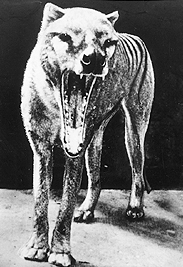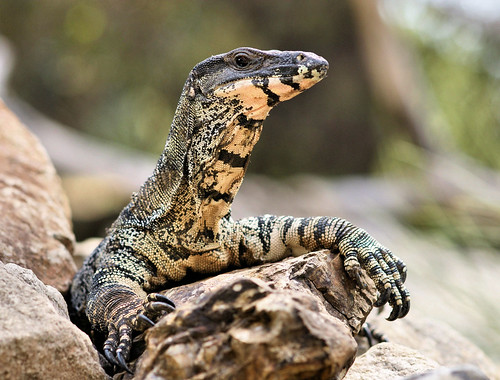Post by Infinity Blade on Oct 8, 2016 8:34:02 GMT 5
Clouded Leopard-Neofelis nebulosa
The clouded leopard (Neofelis nebulosa) is a wild cat found from the Himalayan foothills through mainland Southeast Asia into China. In 2008 it was classified as Vulnerable by the International Union for Conservation of Nature (IUCN). Its total population is suspected to be fewer than 10,000 mature individuals, with a decreasing population trend, and no single population numbering more than 1,000 adults. The fur of clouded leopards is of a dark grey or ochreous ground-colour, often largely obliterated by black and dark dusky-grey blotched pattern. There are black spots on the head, and the ears are black. Partly fused or broken-up stripes run from the corner of the eyes over the cheek, from the corner of the mouth to the neck, and along the nape to the shoulders. Elongated blotches continue down the spine and form a single median stripe on the loins. Two large blotches of dark dusky-grey hair on the side of the shoulders are each emphasized posteriorly by a dark stripe, which passes on to the foreleg and breaks up into irregular spots. The flanks are marked by dark dusky-grey irregular blotches bordered behind by long, oblique, irregularly curved or looped stripes. These blotches yielding the clouded pattern suggest the English name of the cat. The underparts and legs are spotted, and the tail is marked by large, irregular, paired spots. Females are slightly smaller than males. Their irises are usually either greyish-green or brownish-yellow in color. Their legs are short and stout, with broad paws. They have rather short limbs compared to the other big cats, but their hind limbs are longer than their front limbs to allow for increased jumping and leaping capabilities. Their ulnae and radii are not fused, which also contributes to a greater range of motion when climbing trees and stalking prey. Melanistic clouded leopards are uncommon. Clouded leopards weigh between 11.5 and 23 kg (25 and 51 lb). Females vary in head-to-body length from 68.6 to 94 cm (27.0 to 37.0 in), with a tail 61 to 82 cm (24 to 32 in) long. Males are larger at 81 to 108 cm (32 to 43 in) with a tail 74 to 91 cm (29 to 36 in) long. Their shoulder height varies from 50 to 55 cm (20 to 22 in). They have exceptionally long, piercing canine teeth, the upper being about three times as long as the basal width of the socket. The upper pair of canines may measure 4 cm (1.6 in) or longer. They are often referred to as a “modern-day sabre-tooth” because they have the largest canines in proportion to their body size, matching the tiger in canine length. The first premolar is usually absent, and they also have a very distinct long and slim skull with well-developed occipital and sagittal crests to support the enlarged jaw muscles
.JPG)
Thylacine-Thylacinus cynocephalus
The thylacine (/ˈθaɪləsiːn/ thy-lə-seen, or /ˈθaɪləsaɪn/ thy-lə-syne, also /ˈθaɪləsᵻn/; binomial name: Thylacinus cynocephalus, Greek for "dog-headed pouched one") was the largest known carnivorous marsupial of modern times. It is commonly known as the Tasmanian tiger (because of its striped lower back) or the Tasmanian wolf. Native to continental Australia, Tasmania and New Guinea, it is believed to have become extinct in the 20th century. It was the last extant member of its family, Thylacinidae; specimens of other members of the family have been found in the fossil record dating back to the late Oligocene. Surviving evidence suggests that it was a relatively shy, nocturnal creature with the general appearance of a medium-to-large-size dog, except for its stiff tail and abdominal pouch (reminiscent of a kangaroo) and dark transverse stripes that radiated from the top of its back, similar to those of a tiger. The thylacine was an apex predator, like the tigers and wolves of the Northern Hemisphere from which it obtained two of its common names. As a marsupial, it was not closely related to these placental mammals, but because of convergent evolution it displayed the same general form and adaptations. Its closest living relative is thought to be either the Tasmanian devil or the numbat. The thylacine was one of only two marsupials to have a pouch in both sexes (the other being the water opossum). The male thylacine had a pouch that acted as a protective sheath, covering his external reproductive organs while he ran through thick brush. The thylacine has been described as a formidable predator because of its ability to survive and hunt prey in extremely sparsely populated areas. The mature thylacine ranged from 100 to 130 cm (39 to 51 in) long, plus a tail of around 50 to 65 cm (20 to 26 in). Adults stood about 60 cm (24 in) at the shoulder and weighed 20 to 30 kg (40 to 70 lb). There was slight sexual dimorphism with the males being larger than females on average.

The clouded leopard (Neofelis nebulosa) is a wild cat found from the Himalayan foothills through mainland Southeast Asia into China. In 2008 it was classified as Vulnerable by the International Union for Conservation of Nature (IUCN). Its total population is suspected to be fewer than 10,000 mature individuals, with a decreasing population trend, and no single population numbering more than 1,000 adults. The fur of clouded leopards is of a dark grey or ochreous ground-colour, often largely obliterated by black and dark dusky-grey blotched pattern. There are black spots on the head, and the ears are black. Partly fused or broken-up stripes run from the corner of the eyes over the cheek, from the corner of the mouth to the neck, and along the nape to the shoulders. Elongated blotches continue down the spine and form a single median stripe on the loins. Two large blotches of dark dusky-grey hair on the side of the shoulders are each emphasized posteriorly by a dark stripe, which passes on to the foreleg and breaks up into irregular spots. The flanks are marked by dark dusky-grey irregular blotches bordered behind by long, oblique, irregularly curved or looped stripes. These blotches yielding the clouded pattern suggest the English name of the cat. The underparts and legs are spotted, and the tail is marked by large, irregular, paired spots. Females are slightly smaller than males. Their irises are usually either greyish-green or brownish-yellow in color. Their legs are short and stout, with broad paws. They have rather short limbs compared to the other big cats, but their hind limbs are longer than their front limbs to allow for increased jumping and leaping capabilities. Their ulnae and radii are not fused, which also contributes to a greater range of motion when climbing trees and stalking prey. Melanistic clouded leopards are uncommon. Clouded leopards weigh between 11.5 and 23 kg (25 and 51 lb). Females vary in head-to-body length from 68.6 to 94 cm (27.0 to 37.0 in), with a tail 61 to 82 cm (24 to 32 in) long. Males are larger at 81 to 108 cm (32 to 43 in) with a tail 74 to 91 cm (29 to 36 in) long. Their shoulder height varies from 50 to 55 cm (20 to 22 in). They have exceptionally long, piercing canine teeth, the upper being about three times as long as the basal width of the socket. The upper pair of canines may measure 4 cm (1.6 in) or longer. They are often referred to as a “modern-day sabre-tooth” because they have the largest canines in proportion to their body size, matching the tiger in canine length. The first premolar is usually absent, and they also have a very distinct long and slim skull with well-developed occipital and sagittal crests to support the enlarged jaw muscles
Thylacine-Thylacinus cynocephalus
The thylacine (/ˈθaɪləsiːn/ thy-lə-seen, or /ˈθaɪləsaɪn/ thy-lə-syne, also /ˈθaɪləsᵻn/; binomial name: Thylacinus cynocephalus, Greek for "dog-headed pouched one") was the largest known carnivorous marsupial of modern times. It is commonly known as the Tasmanian tiger (because of its striped lower back) or the Tasmanian wolf. Native to continental Australia, Tasmania and New Guinea, it is believed to have become extinct in the 20th century. It was the last extant member of its family, Thylacinidae; specimens of other members of the family have been found in the fossil record dating back to the late Oligocene. Surviving evidence suggests that it was a relatively shy, nocturnal creature with the general appearance of a medium-to-large-size dog, except for its stiff tail and abdominal pouch (reminiscent of a kangaroo) and dark transverse stripes that radiated from the top of its back, similar to those of a tiger. The thylacine was an apex predator, like the tigers and wolves of the Northern Hemisphere from which it obtained two of its common names. As a marsupial, it was not closely related to these placental mammals, but because of convergent evolution it displayed the same general form and adaptations. Its closest living relative is thought to be either the Tasmanian devil or the numbat. The thylacine was one of only two marsupials to have a pouch in both sexes (the other being the water opossum). The male thylacine had a pouch that acted as a protective sheath, covering his external reproductive organs while he ran through thick brush. The thylacine has been described as a formidable predator because of its ability to survive and hunt prey in extremely sparsely populated areas. The mature thylacine ranged from 100 to 130 cm (39 to 51 in) long, plus a tail of around 50 to 65 cm (20 to 26 in). Adults stood about 60 cm (24 in) at the shoulder and weighed 20 to 30 kg (40 to 70 lb). There was slight sexual dimorphism with the males being larger than females on average.













